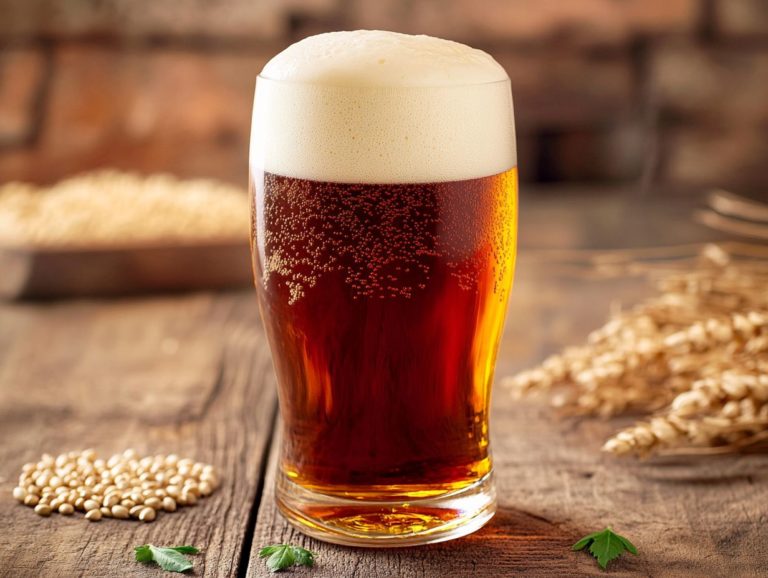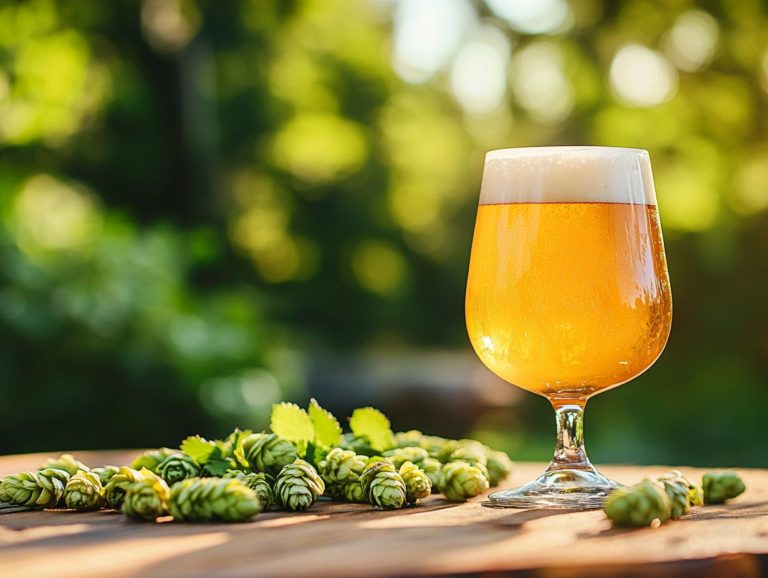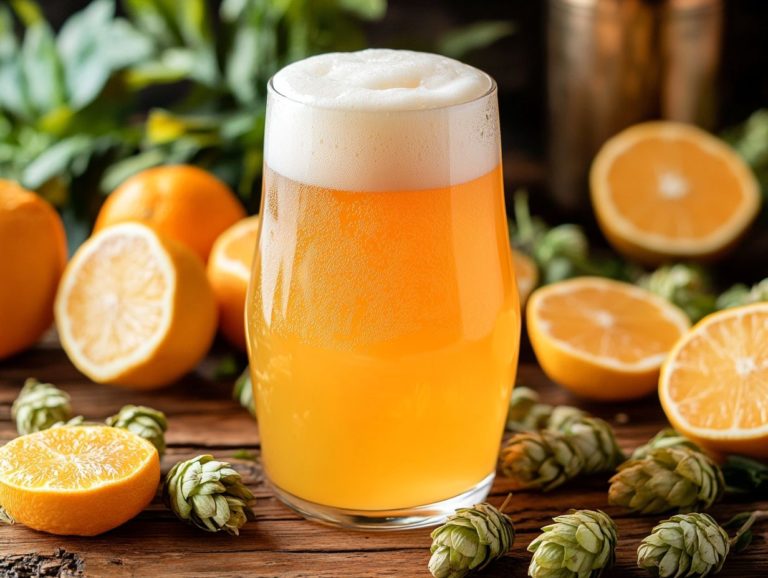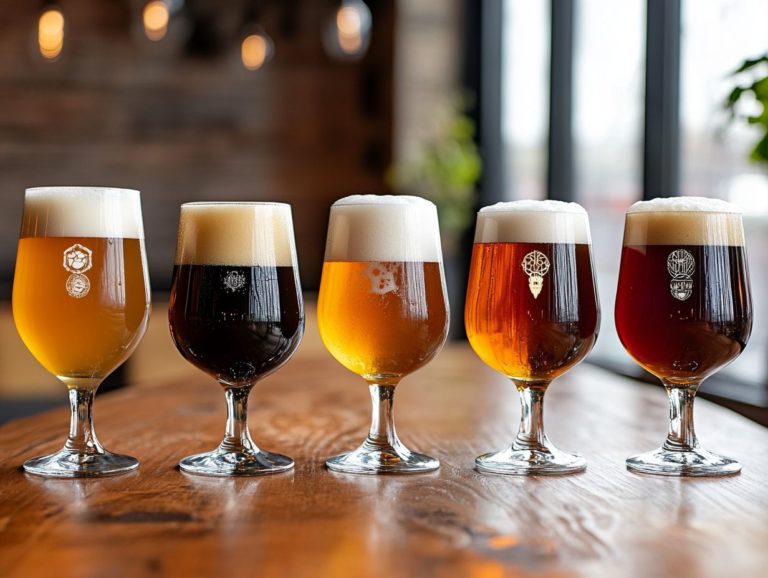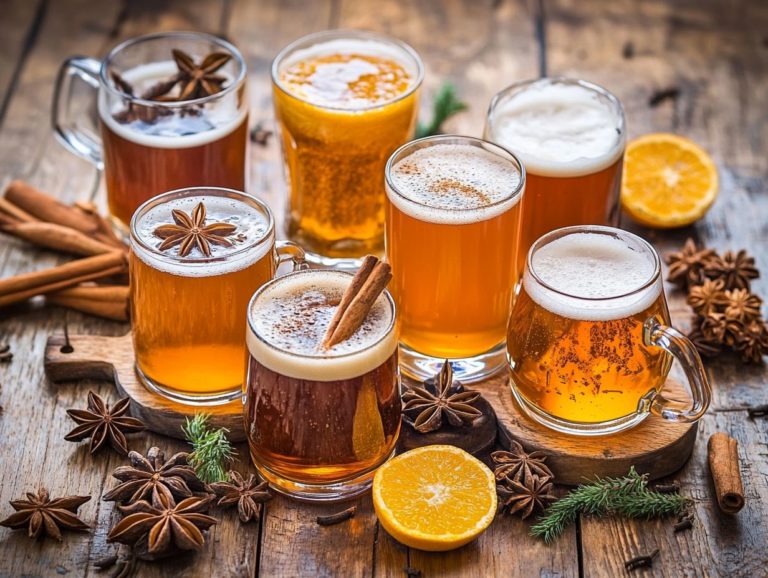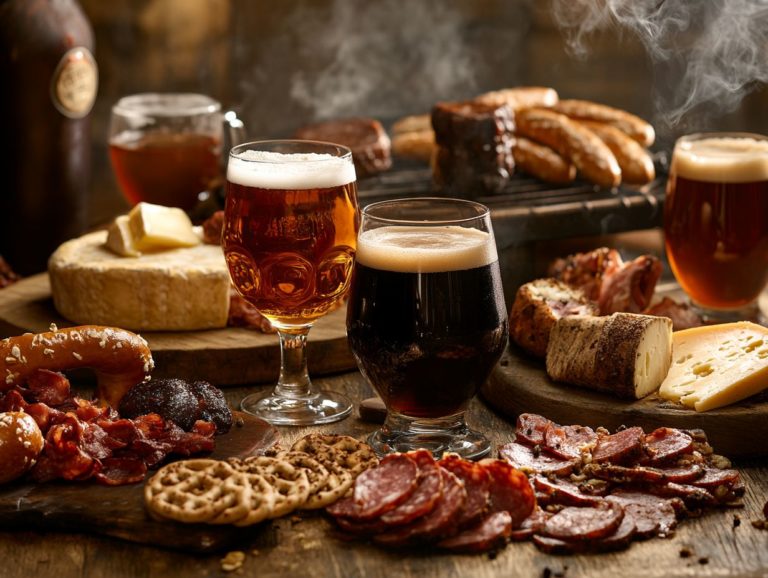The Science Behind Sour Beers Explained
Sour beers present a captivating departure from traditional brews, enticing adventurous palates with their unique tang, tart flavors, and complexity. You ll also discover the potential health benefits that accompany the enjoyment of these tart delights, stemming from a healthy fermentation process. Get ready for an exhilarating dive into the world of sour beers!
This article invites you to explore the intriguing realm of sour beers, tracing their rich history, brewing traditions, and delving into the fascinating science behind their distinctive flavors.
From the wild yeast and bacteria that create sour profiles to the various styles, such as Lambic, Berliner Weisse, and Flanders Brown, you will uncover the intricate brewing processes that bring these exceptional beers to life.
Contents
- Key Takeaways:
- What Are Sour Beers?
- History of Sour Beers
- What Makes Sour Beers Sour?
- Types of Sour Beers
- Sour Beer Styles
- 3. Fermentation (a key beer fermentation step)
- 4. Aging (in fermentation cellars)
- How Do Sour Beers Get Their Flavors?
- The Art of Crafting Sour Beers
- Health Benefits of Sour Beers
- Frequently Asked Questions
- What makes sour beers different from other types of beer?
- What is the science behind the souring process in sour beers?
- How does the brewing process for sour beers differ from other types of beer?
- Are there health benefits to drinking sour beers?
- Why do some people have a strong reaction to the sour taste in sour beers?
- Are there different types of sour beers based on the souring process?
Key Takeaways:
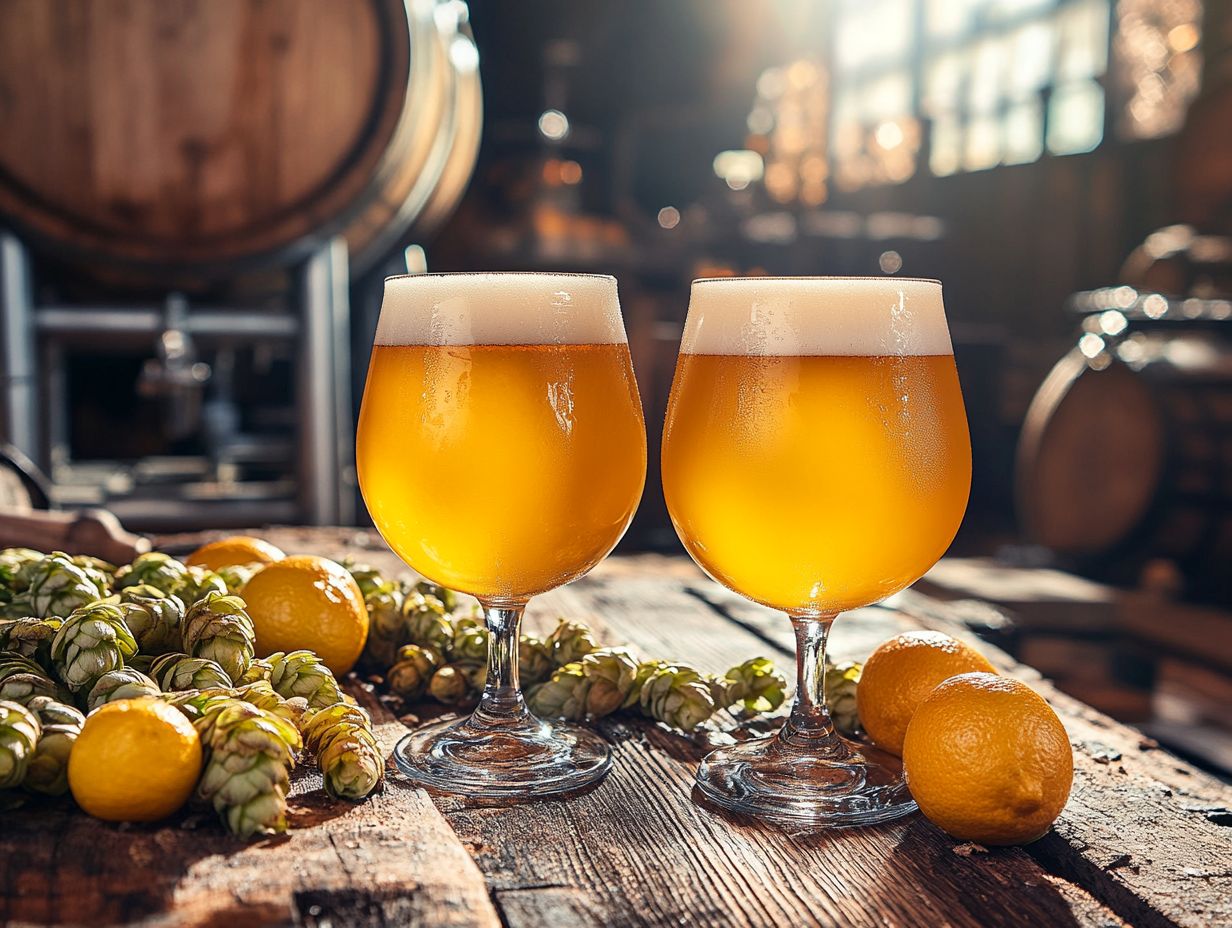
- Sour beers get their distinct sour flavors from a combination of wild yeast, a type of bacteria called Lactobacillus, Pediococcus bacteria, and different types of acids.
- Sour beers have a rich history dating back centuries and have evolved into a variety of styles such as Lambic, Flanders Red Ale, and Berliner Weisse.
- The brewing process of sour beers involves special techniques such as extended fermentation, spontaneous fermentation, and barrel aging to create complex and unique flavors.
What Are Sour Beers?
Sour beers, with their tart flavors and distinctive acidity levels, offer a fascinating niche in the expansive world of beer styles. These innovative brewing techniques have given rise to a range of sour beer varieties, including kettle souring, that entice you with their complex and intriguing flavor profiles.
Whether you re exploring the creations of American craft breweries like Russian River Brewing and Victory Brewing, or savoring traditional Belgian lambics from Cantillon, you ll discover how different fermentation processes bring out the unique contributions of various yeasts and bacteria, making each sip a captivating experience.
History of Sour Beers
The history of sour beers is both rich and diverse, tracing back to ancient brewing traditions that embraced wild fermentation and distinctive flavor profiles.
You can appreciate how the historical styles of Belgian lambics paved the way for modern interpretations crafted by American craft breweries, such as Two Roads Brewing and Allagash Brewing.
This journey of sour beer not only highlights the evolution of brewing techniques but also reflects the cultural influences that have shaped these styles across different regions.
What Makes Sour Beers Sour?
The sourness you experience in sour beers primarily comes from distinctive fermentation processes that involve an array of microorganisms, including Lactobacillus bacteria, Pediococcus bacteria, and Brettanomyces yeast. These processes are employed by many innovative breweries in the craft beer scene.
These wild yeasts and bacteria impart unique acidity levels and flavor combinations, enriching the overall complexity of the beer s flavor profile and playing a pivotal role in determining the intensity of its sourness. Incorporating unique strains can further enhance the distinctiveness of each brew.
1. Wild Yeast and Bacteria
Wild yeasts and bacteria are absolutely essential in crafting sour beers, with strains like Lactobacillus and Pediococcus taking center stage in the fermentation process. These microorganisms thrive in fermentation cellars, where their unique characteristics contribute to the sourness and complexity of the final product.
These tiny powerhouses don t just add a tangy kick; they also enrich the flavor profile, creating a distinctive experience that can range from fruity to earthy. Embracing traditional fermentation practices often invites a bit of spontaneity, allowing wild yeasts from the environment to mingle with cultured strains. This natural approach can yield unpredictable yet captivating results, emphasizing how the brewing environment affects the beer.
Controlling fermentation conditions like temperature and pH is vital for achieving the perfect balance of sourness and flavor depth. This ensures that the final beer not only aligns with your vision as a brewer but also pays homage to the delightful chaos of wild fermentation.
2. Lactic Acid
Lactic acid plays a pivotal role in shaping the flavor profiles of sour beers, imparting that signature tartness and refreshing acidity you adore. This organic compound is crafted during fermentation by lactic acid bacteria, making effective acidity control crucial for achieving the perfect balance in your favorite sour beer styles.
During fermentation, sugars are transformed into lactic acid, enriching the beer’s complexity and delivering a unique sensory experience with every sip. Brewmasters often utilize an array of techniques, such as blending different yeast strains or meticulously controlling fermentation temperatures, to fine-tune acidity levels and ensure the final product is both well-rounded and enticing. Effective acidity control is crucial for achieving the desired balance in these brews.
Grasping the delicate interplay between sweetness and acidity can significantly enhance your tasting experience. Too much lactic acid might overwhelm your palate, but when balanced just right, it can elevate the beer’s overall profile, resulting in a truly delightful sipping journey that aligns with contemporary consumer preferences.
3. Acetic Acid
Acetic acid, a byproduct of certain fermentation processes, has the potential to impart distinct flavors to sour beers. While it can add complexity, it also carries the risk of introducing undesirable off-flavors. Understanding its role is essential for you as a brewer aiming to craft a harmonious flavor profile in your sour beer styles.
This organic compound is typically produced by acetobacter during fermentation, and its presence can significantly influence the overall tasting experience. In moderate amounts, acetic acid enhances the tartness and depth of flavors, particularly in styles like Oud Bruin and Flanders Red Ales, where a hint of acidity beautifully complements the malt backbone.
However, excessive levels can lead to unpleasant vinegar-like characteristics, which can be detrimental to styles such as Berliner Weisse or American Wild Ales, where a clean and refreshing finish is crucial.
To navigate this delicate balance, you can employ techniques such as careful temperature control and blending, allowing you to manage acetic acid levels and achieve the desired flavor profile in your creations, ensuring a harmonious combination of flavor components.
4. Citric Acid
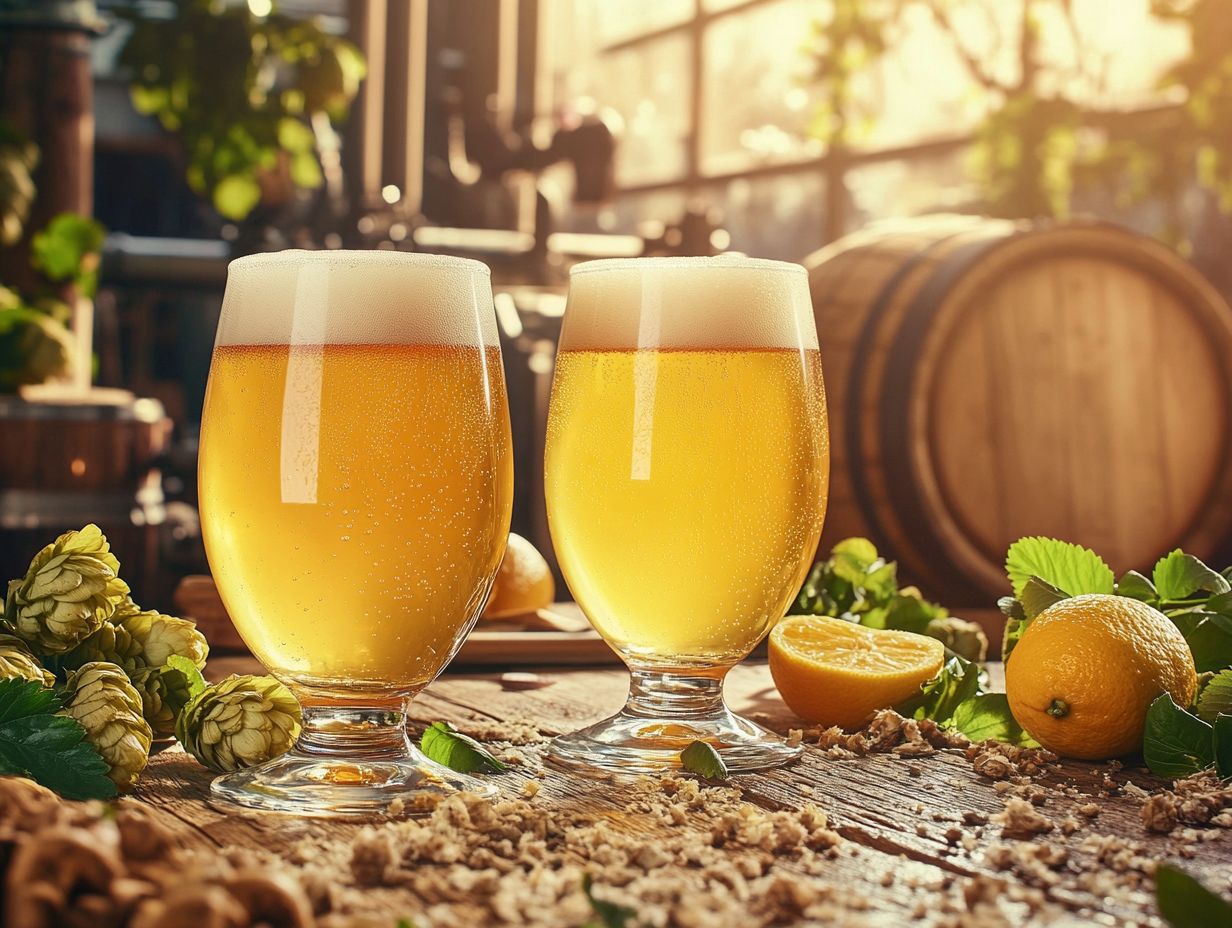
Citric acid, often linked to vibrant fruity flavors, elevates the sensory experience of sour beers, infusing them with a refreshing and zesty character. Its inclusion adds an intriguing layer to the complex flavor profiles that define various sour beer styles.
This organic acid, derived from citrus fruits, plays a vital role in crafting those bright, tangy notes that harmonize beautifully with other acids found in these brews. For example, when paired with lactic or acetic acid, citric acid can enhance the tartness and roundness of a beer’s flavor profile, making styles like Gose or Berliner Weisse especially lively.
The interplay of these acids not only contributes to the mouthfeel but also boosts the overall drinkability of the beer, inviting you to savor each sip and making it a perfect choice for warm weather. Incorporating fruits like lemons and oranges in certain recipes can further amplify citric acid s impact, delivering a truly refreshing experience that will captivate any sour beer enthusiast.
Types of Sour Beers
You ll discover a captivating array of sour beer styles, each boasting its own distinct characteristics and flavor profiles that cater to a wide range of tastes.
Among the most notable examples are Flanders red, Berliner Weisse, Gose, and traditional lambics, all of which beautifully highlight the artistry of mixed-culture fermentation and the ingenuity of contemporary brewing techniques. These sour beer styles showcase the diversity and creativity of the craft beer scene.
Sour Beer Styles
1. Lambic
Lambics are a renowned Belgian sour beer style that stands out for their unique production method. They involve fermentation with wild yeasts and bacteria from the local environment, resulting in complex flavors that set lambics apart from other sour beer styles.
The outcome is a beer that can vary from mildly tart to intensely sour. Its flavor profiles often feature fruity, earthy, and occasionally funky notes, capturing the essence of where the ingredients are sourced. Historically, these beers have played a significant role, paving the way for modern sour brew appreciation and showcasing craftsmanship steeped in centuries of brewing innovation.
Variations like Gueuze a blend of young and old lambics exemplify a harmonious balance between sweetness and acidity. On the other hand, Kriek introduces cherries, infusing vibrant fruitiness and color. Each type of lambic carries unique attributes that reflect both the ingredients and local brewing traditions influencing their production. The use of Belgian yeast strains enhances the complexity and depth of these traditional brews.
2. Flanders Red Ale
Flanders Red Ale is a remarkable sour beer style from Belgium. It is marked by its deep red color and complex flavor profile, tantalizing the palate with notes of dark fruit, oak, and a hint of vinegar. This beer often undergoes a lengthy aging process in wooden barrels, cultivating its signature complexity. This fermentation timeline is crucial for developing intricate flavors characteristic of this style.
Craft breweries have embraced this traditional brewing technique, excited by the unique and layered tastes that Flanders Red Ale offers. During the aging process, wild yeast, lactic acid bacteria, and Pediococcus bacteria play pivotal roles in imparting tartness and character to the beer. Fermentation in oak barrels adds subtle flavors from the wood, further enhancing its profile.
The popularity of this style has surged, leading many breweries to experiment with various interpretations. They incorporate local ingredients to create distinctive takes on this classic ale, often resulting in complex flavors. Flanders Red Ale not only demonstrates artistry in sour brewing but also represents a broader trend within the craft beer community, inviting you to explore the rich depth and diversity of sour beer styles.
3. Berliner Weisse
Berliner Weisse is a delightful German sour beer that you ll appreciate for its low alcohol content and refreshing tartness. It is often accompanied by a symphony of fruity flavors. Typically, it s enjoyed with flavored syrups, elevating it as the perfect summer beverage.
This intriguing brew is crafted through a distinctive fermentation process that combines traditional yeast with Lactobacillus bacteria and Brettanomyces yeast, lending it captivating sourness. The result is a light, effervescent drink with a citrusy and slightly earthy profile, making it incredibly thirst-quenching and perfect for warm days.
Recently, there has been a renaissance of Berliner Weisse among craft breweries, with innovative brewers experimenting with various fruit additions and techniques. This resurgence not only pays homage to the classic style but also opens up an expansive range of creative interpretations. Explore an array of diverse flavor combinations and tart flavors that will truly elevate your drinking experience. Don t miss out on trying this refreshing summer classic!
4. Gose
Gose is a captivating sour beer style from Germany. It is celebrated for its refreshing and subtly salty profile, enhanced by delightful notes of coriander and a whisper of citrus. Gose also often has acidity levels that add to its overall character. This fascinating mix of flavors offers a unique tasting adventure that truly sets Gose apart from other sour varieties.
Its roots trace back to the historic city of Goslar. There, the mineral-rich waters of the Gose River inspired local brewers to embark on an adventurous brewing journey. They adhered to historical styles and brewing traditions. The salt addition elevates the beer’s salinity and harmonizes beautifully with its gentle tartness. Meanwhile, coriander introduces a spicy, aromatic freshness that dances on your palate.
As craft breweries around the world, like Anderson Valley and Westbrook, embrace this style, Gose has experienced a remarkable surge in popularity. It attracts adventurous beer enthusiasts who appreciate its lively character. With an influx of infusions and creative variations, Gose has successfully transitioned from traditional settings to contemporary gatherings. It has firmly established its presence in today s craft beer landscape.
The Brewing Process of Sour Beers and Fermentation Techniques
The brewing process of sour beers includes carefully controlled steps: mashing, boiling, fermentation, and aging. These steps follow traditional brewing techniques.
Each stage plays a vital role in shaping the final flavor and character of the beer. They contribute to its sourness intensity. Understanding this process is crucial for brewers who aspire to make great sour beers that people love.
1. Mashing (including sour mash)
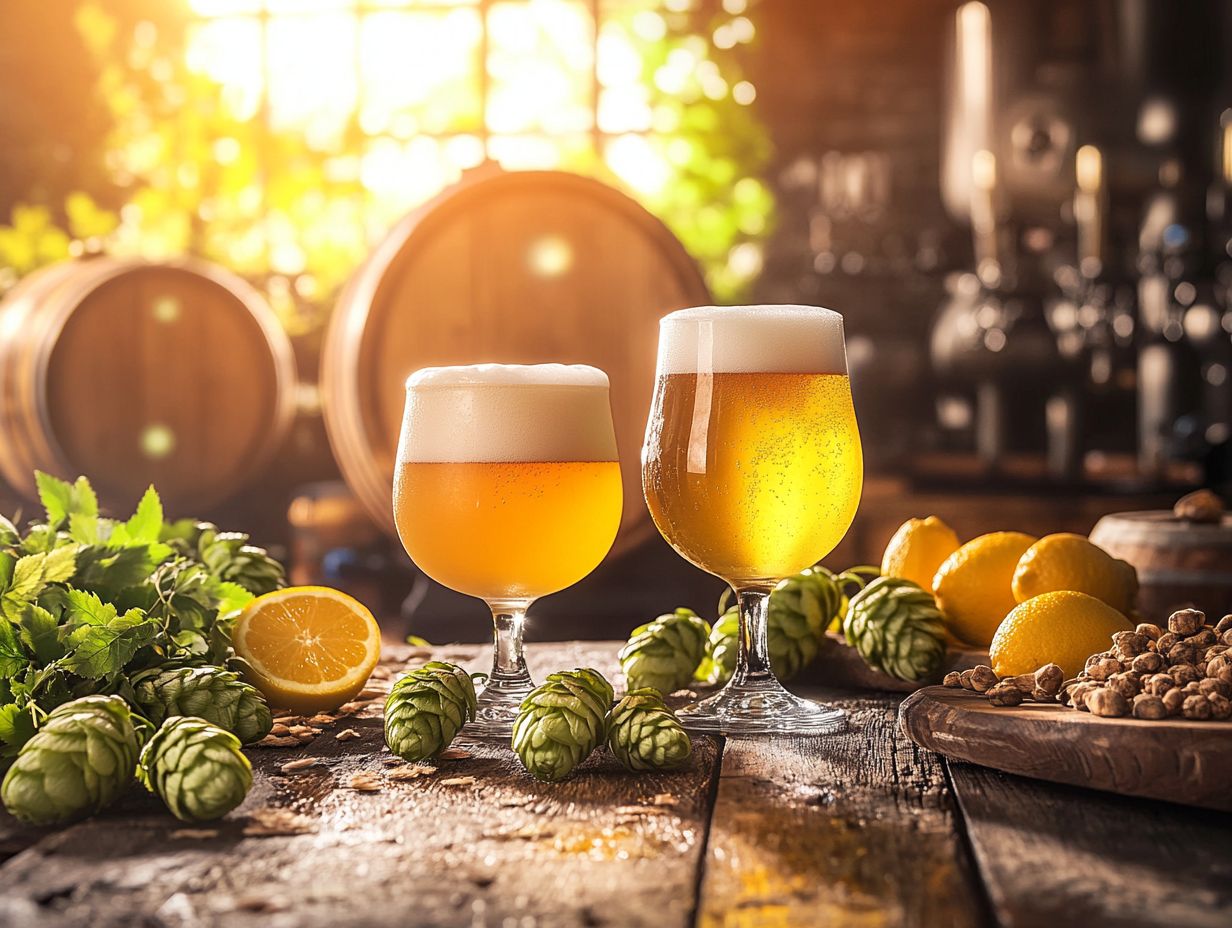
Mashing is the crucial first step in brewing sour beers. In this stage, you’ll mix crushed grains with hot water to extract precious fermentable sugars, which are key to shaping the beer’s flavor profile. You might even consider using a sour mash to give the fermentation process a head start. This introduces Lactobacillus bacteria (a type of bacteria that helps create sour flavors) right from the beginning.
This vital step lays the groundwork for both sugar content and distinct flavor nuances that define sour beers. By creating a sweet wort, you can influence how various strains of yeast and bacteria interact during fermentation. This leads to a captivating outcome.
The sour mashing technique involves intentionally souring the wort by adding pre-fermented mash. This unfolds a complex array of flavors, enhancing acidity and imparting delightful tangy notes. This method is essential for anyone eager to explore the rich intricacies of sour beer production.
2. Boiling (essential for flavor components)
Boiling is an essential step in brewing sour beers. During this process, you add hops to the wort to balance flavors and provide bitterness that counteracts the sourness. This boiling process sterilizes the wort and extracts vital oils from the hops.
This crucial stage ensures you have a clean base for fermentation. It significantly shapes the beer’s overall character. The choice of hops introduces a delightful spectrum of flavors ranging from floral and citrusy to earthy and piney. These create complex layers that beautifully harmonize with the tartness brought by souring bacteria.
Varieties like Saaz or Hallertau are often preferred for their delicate aroma. In contrast, bolder hops like Citra or Simcoe can impart a more pronounced flavor profile.
Ultimately, your careful selection and timing of hop additions during the boil greatly influence the balance between bitterness and acidity. This also helps control off-flavors, crafting a unique and enjoyable drinking experience that truly stands out.
3. Fermentation (a key beer fermentation step)
Fermentation is the key stage in your sour beer production journey, where wild yeast and bacteria work their magic on the sugars in the wort, transforming them into alcohol and a variety of acids that shape the beer’s unique character. When you engage in mixed-culture fermentation, you’re inviting multiple strains to the party, adding delightful complexity to the final product.
In this intricate dance, various yeast species play a part in crafting the flavor and aroma of your brew. Saccharomyces takes the lead during primary fermentation, efficiently converting sugars into alcohol, while Brettanomyces yeast and Pediococcus bacteria contribute to the complex flavor profile. In contrast, Brettanomyces adds those intriguing funky, earthy notes through its leisurely fermentation approach. Meanwhile, Lactobacillus introduces lactic acid, imparting that signature tartness that sour beer aficionados cherish, a key aspect of many sour beer styles.
Embracing mixed-culture fermentation not only enriches the flavor complexity but also elevates the overall mouthfeel and aromatic profile of your beer, allowing for delightful variations with every batch you craft. This diversity is what many enthusiasts revel in, as it ensures that no two sour beers are ever quite the same, thanks to the varied fermentation techniques used.
4. Aging (in fermentation cellars)
Aging is a key stage in the creation of sour beers, allowing the flavors to mature and develop delightful complexity over time. Many sour beers are aged in fermentation cellars, often in wooden barrels, where they can absorb the distinct characteristics of the wood and undergo further fermentation.
Maturation enriches the flavors, introducing layers of depth and a variety of interesting flavors that can dramatically transform the beer’s character, often requiring long aging periods. You ll find that various techniques, such as blending different aged batches or employing secondary fermentation (which occurs after primary fermentation and allows for further flavor development), enhance these complexities, making each beer production unique.
The choice of barrel is also crucial; for instance, bourbon barrels can impart rich vanilla and caramel tones, while wine barrels may offer fruity nuances and a hint of acidity from their previous contents, such as red wine.
By thoughtfully selecting barrel types and aging methods, you can create a remarkable balance that elevates your beer to new heights, ensuring a unique tasting experience that will delight even the most discerning enthusiasts and adhere to consumer preferences.
How Do Sour Beers Get Their Flavors?
Sour beers acquire their distinctive flavors through a sophisticated blend of methods, such as barrel aging, fruit additions, and meticulous blending techniques. Each of these elements contributes unique characteristics to the final product.
This multifaceted approach gives you the power to explore sour beers that cater to a diverse array of palates and preferences, inviting you to discover new and exciting taste experiences, influenced by various fermentation timelines.
The Art of Crafting Sour Beers
1. Barrel Aging
Barrel aging is a highly esteemed technique in crafting sour beers, allowing them to cultivate a remarkable complexity of flavors as they mingle with the wood and residual yeast from their previous occupants. This process significantly elevates the beer’s character, often bestowing delightful notes of oak, vanilla, and even a hint of wine.
When choosing the barrel type whether it s American oak, French oak, or barrels that once cradled spirits like bourbon or rum each option leaves a distinct mark on the final profile of your sour beer and aids in acidity control. For example, American oak tends to impart bolder flavors of vanilla and coconut. In contrast, French oak adds a more nuanced spiciness and delicate tannin structure.
The history of the barrel is equally critical; a barrel that previously aged a robust red wine can introduce fruity characteristics and tannins that beautifully complement the tartness of the sour beer, offering a deeper flavor profile.
Ultimately, barrel aging not only deepens flavor complexity but also enriches the sensory journey, crafting a multifaceted drink that continues to evolve and surprise with every sip. This process thrives on the wild yeast strains, creating vibrant and unexpected flavors, and is influenced by the careful control of acidity levels.
2. Fruit Additions
Enhancing the flavor profiles of sour beers through fruit additions is a popular and delightful practice, seamlessly adding fresh, tart character and vibrant fruity flavors. This approach elevates your sensory experience while introducing exciting new layers of complexity to the beer itself, building on traditional brewing techniques.
You ll often find fruits like cherries, raspberries, and peaches making their way into these brews, each bringing its unique notes that beautifully complement the beer’s inherent sourness and acidity. For instance, cherries lend a deep, rich tartness, while raspberries provide a bright, effervescent zing. These fruits frequently appear in traditional sour beer styles like Flanders red and Belgian lambics.
The acidity from these fruits works in harmony with the lactic sourness, crafting a balanced and refreshing profile that captivates the palate. This balance is essential in maintaining the desired sourness intensity and avoiding off-flavors.
Tropical varieties such as passion fruit and pineapple add their exotic sweetness and juiciness, enhancing the drinkability of these creations. These fruit additions not only elevate the complexity of sour beers but also engage enthusiasts like yourself, inviting exploration of diverse and intriguing flavor combinations. Additionally, tropical fruits are frequently featured in innovative brews by American craft breweries.
3. Blending
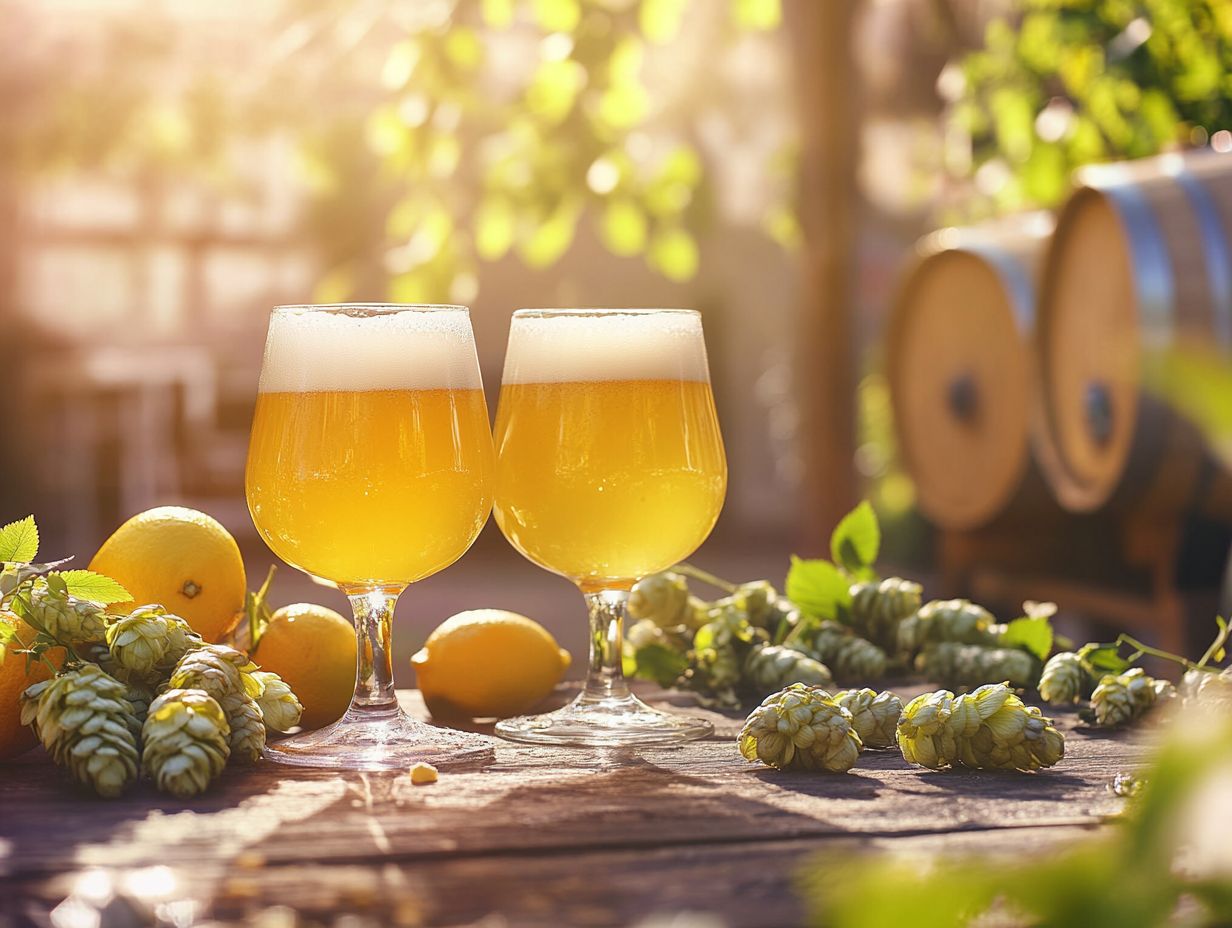
Blending is a technique that you, as a brewer, can employ to achieve sought-after flavor combinations in sour beers. It allows you to integrate different batches and create a balanced, harmonious product. This method significantly influences the final flavor profile and overall complexity of your beer, especially when working with varied beer fermentation practices.
As you carefully select various base beers, each one contributes its unique characteristics, from tartness and acidity to fruity and funky notes. Your goal is to thoughtfully combine these different batches, taking full advantage of the unique fermentation processes that yield rich and diverse flavors. This practice often involves using mixed-culture fermentation, which utilizes different types of yeast and bacteria to create unique flavors, and a well-maintained fermentation cellar.
By experimenting with proportions and aging techniques, you strive to craft a finished product that delights the palate while offering something truly exceptional. The blending process is vital, enhancing the complexity of sour beers while ensuring consistency across batches. This way, you allow enthusiasts to savor unique flavor combinations while upholding the highest standards of quality. This is particularly important when considering the influence of regional breweries and their historic brewing traditions.
Ready to explore the world of sour beers? Experiment with your own brewing processes and discover the exciting flavors waiting for you!
Health Benefits of Sour Beers
Sour beers provide you with a distinct tasting experience. They also present potential health benefits due to their rich probiotic content and beneficial lactic acid bacteria. The presence of Lactobacillus and Pediococcus bacteria enhances the healthy fermentation process.
As the craft beer landscape continues to evolve, more consumers are becoming aware of the holistic advantages that come with savoring these fermented delights. Innovative breweries like Russian River Brewing, Victory Brewing, and Allagash Brewing are driving these sour beer trends.
Frequently Asked Questions
What makes sour beers different from other types of beer?
Sour beers are intentionally brewed to have a sour or tart flavor. This is achieved through a process called souring, which involves introducing bacteria or wild yeast strains during brewing, creating lactic acid and other compounds that give sour beers their unique flavor profile.
Common strains used include Lactobacillus, Pediococcus, and Brettanomyces.
What is the science behind the souring process in sour beers?
The souring process is a result of complex microbial interactions between yeast and bacteria. This interaction creates a variety of compounds, such as lactic acid and acetic acid, contributing to the characteristic sour taste of sour beers.
Common bacteria used in this process include Lactobacillus and Pediococcus, along with wild yeast strains like Brettanomyces.
How does the brewing process for sour beers differ from other types of beer?
The brewing process for sour beers includes an additional step called “souring.” Traditional beers undergo fermentation to convert sugars into alcohol, while sour beers go through a secondary fermentation process that introduces bacteria or wild yeast strains to create the sour flavor.
This secondary process can take anywhere from weeks to several months, depending on the desired level of sourness. Techniques such as kettle souring and spontaneous fermentation are commonly employed to achieve specific flavor profiles.
Are there health benefits to drinking sour beers?
Moderate alcohol consumption can have some health benefits, but there are no unique health advantages to drinking sour beers compared to other beer types. However, the presence of probiotic bacteria in some sour beers may promote gut health and aid digestion.
The intensity of sourness and probiotic content are influenced by the fermentation timeline and healthy fermentation practices.
Why do some people have a strong reaction to the sour taste in sour beers?
People may react strongly to the sour taste due to personal taste preferences or the beer’s level of sourness. The sour taste can also be linked to compounds like acetic acid, which may evoke strong reactions in some individuals.
Controlling acidity levels is crucial for managing consumer preferences.
Are there different types of sour beers based on the souring process?
Yes, different types of sour beers exist based on the souring process, including spontaneously fermented sour beers, kettle sour beers, and barrel-aged sour beers. Each method involves different techniques, resulting in unique flavor profiles.
Historical styles like Berliner Weisse, Gose, and Flanders brown highlight the diversity within sour beer styles.

